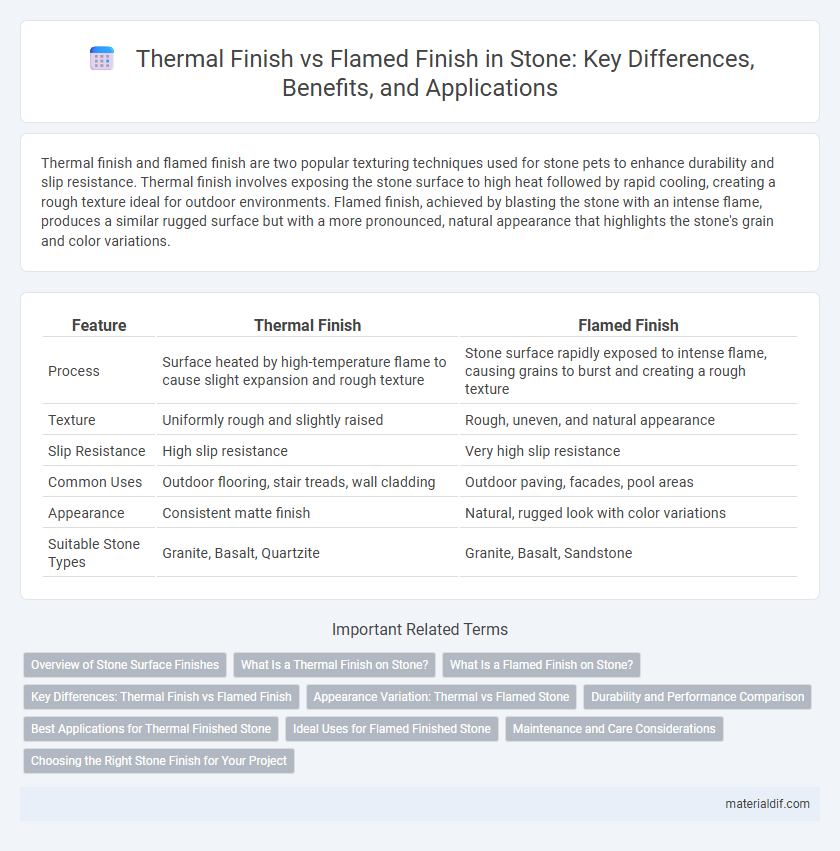Thermal finish and flamed finish are two popular texturing techniques used for stone pets to enhance durability and slip resistance. Thermal finish involves exposing the stone surface to high heat followed by rapid cooling, creating a rough texture ideal for outdoor environments. Flamed finish, achieved by blasting the stone with an intense flame, produces a similar rugged surface but with a more pronounced, natural appearance that highlights the stone's grain and color variations.
Table of Comparison
| Feature | Thermal Finish | Flamed Finish |
|---|---|---|
| Process | Surface heated by high-temperature flame to cause slight expansion and rough texture | Stone surface rapidly exposed to intense flame, causing grains to burst and creating a rough texture |
| Texture | Uniformly rough and slightly raised | Rough, uneven, and natural appearance |
| Slip Resistance | High slip resistance | Very high slip resistance |
| Common Uses | Outdoor flooring, stair treads, wall cladding | Outdoor paving, facades, pool areas |
| Appearance | Consistent matte finish | Natural, rugged look with color variations |
| Suitable Stone Types | Granite, Basalt, Quartzite | Granite, Basalt, Sandstone |
Overview of Stone Surface Finishes
Thermal finish and flamed finish are both stone surface treatments designed to enhance texture and slip resistance by exposing the stone to extreme heat. Thermal finish involves heating the stone with a high-temperature flame, causing the surface to burst and reveal a rough, natural texture, ideal for outdoor applications. Flamed finish is a specific type of thermal treatment primarily used on granite, creating a rough, anti-slip surface while preserving the stone's natural appearance.
What Is a Thermal Finish on Stone?
A thermal finish on stone involves exposing the surface to intense heat using a high-temperature flame, causing the minerals to expand and the surface to fracture slightly, resulting in a textured, non-slip finish. This process enhances the stone's natural color and provides increased durability, making it ideal for outdoor applications such as walkways and patios. Thermal finishes are commonly applied to granite and basalt due to their heat resistance and structural integrity.
What Is a Flamed Finish on Stone?
A flamed finish on stone is created by exposing the surface to intense heat from a torch or flame, causing the minerals to burst and creating a rough, textured appearance ideal for outdoor use. This treatment enhances slip resistance and highlights the natural grain and color variations within the stone. Unlike a thermal finish, which generally produces a smoother, more uniform surface, the flamed finish results in a rugged, deeply textured facade that emphasizes durability and aesthetic appeal.
Key Differences: Thermal Finish vs Flamed Finish
Thermal finish involves exposing stone to high-temperature flames, causing surface crystals to burst and create a rough texture ideal for slip resistance. Flamed finish uses direct flame to rapidly heat the stone surface, resulting in a coarse, uneven look with enhanced durability and anti-slip properties. Both finishes enhance stone's aesthetics and functionality but differ in heating technique and surface texture outcomes.
Appearance Variation: Thermal vs Flamed Stone
Thermal finish stone exhibits a rough, textured surface with subtle color variations caused by high-temperature treatment, enhancing its natural grain and depth. Flamed finish stone reveals a more pronounced, rugged texture characterized by sharp, raised crystals and striking color contrasts due to rapid cooling after intense flame application. Both finishes create unique aesthetic effects, with thermal offering a softer, weathered appearance and flamed providing a bold, dramatic look ideal for outdoor pavements and facades.
Durability and Performance Comparison
Thermal finish stone undergoes rapid heating followed by immediate cooling, enhancing its durability by increasing resistance to wear, impact, and weathering, making it ideal for exterior applications. Flamed finish stone, created by exposing the surface to high-temperature flames that cause rapid expansion and fracturing, results in a rough texture with excellent slip resistance but slightly lower structural strength compared to thermal finish. Both finishes improve stone performance, yet thermal finish typically offers greater long-term durability in high-traffic or harsh environmental conditions.
Best Applications for Thermal Finished Stone
Thermal finished stone is ideal for exterior applications such as building facades, walkways, and pool areas due to its enhanced slip resistance and durability under extreme weather conditions. This finish provides a rough, textured surface achieved by exposing the stone to high temperatures, making it suitable for environments requiring safety and aesthetic appeal. Its resistance to thermal shock and minimal maintenance requirements also make it perfect for commercial and high-traffic outdoor spaces.
Ideal Uses for Flamed Finished Stone
Flamed finish stone is ideal for outdoor applications such as walkways, patios, and pool surrounds due to its rough, non-slip surface that enhances safety and durability. This finish makes granite and other hard stones resistant to weathering and wear in high-traffic areas. Its textured appearance also adds a natural, rustic aesthetic suitable for landscapes and exterior cladding.
Maintenance and Care Considerations
Thermal finish stone surfaces require minimal maintenance, as their heat treatment creates a durable, non-porous texture that resists stains and moisture. Flamed finish stone, with its rough and uneven surface, demands more frequent cleaning to prevent dirt accumulation and may need specialized sealing to maintain its appearance. Both finishes benefit from regular dusting and avoiding harsh chemical cleaners to preserve their integrity over time.
Choosing the Right Stone Finish for Your Project
Thermal finish stone offers a rough texture and enhanced slip resistance, making it ideal for outdoor pathways and pool surrounds where safety is paramount. Flamed finish stone provides a rugged, natural appearance with irregular surface variations, suitable for decorative walls and ground surfaces seeking a rustic aesthetic. Selecting the right stone finish depends on balancing functional requirements like durability and traction with the desired visual effect for your architectural or landscaping project.
Thermal Finish vs Flamed Finish Infographic

 materialdif.com
materialdif.com